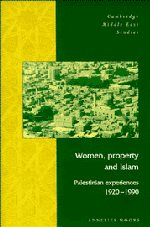2 - The lives of four women: introducing property and politics
from Part I - Politics, economy and kinship
Published online by Cambridge University Press: 05 July 2011
Summary
After a sketch of the international context, this chapter introduces the main property-related developments in the Jabal Nablus region through the life stories of four women from diverse backgrounds and locations. Certainly, the historical transformation of Palestine has affected the lives of all of them. Yet their experiences also show considerable variation. The gap between rural and urban life in Jabal Nablus has been wide, the experiences of the wealthy had little in common with those of the poor, and the life courses of the women who came as refugees to Nablus show particular discontinuities.
Palestine: the international context
In Ottoman times, the Jabal Nablus region was the most continuously and densely populated region of Palestine, covering the central portion of the interior hills which run in a north–south direction. While Jabal means mountain, the term Jabal Nablus referred to the whole rural hinterland under the control of the city of Nablus, reaching from the coastal plains on the West to the Jordan Valley in the East. Whereas Jabal Nablus had once been a relatively autonomous region of the Ottoman Empire, in the nineteenth century the Ottoman rulers succeeded in strengthening their control over this area.
- Type
- Chapter
- Information
- Women, Property and IslamPalestinian Experiences, 1920–1990, pp. 17 - 47Publisher: Cambridge University PressPrint publication year: 1996



